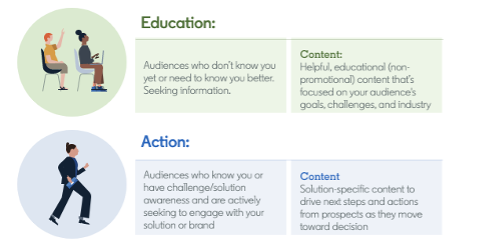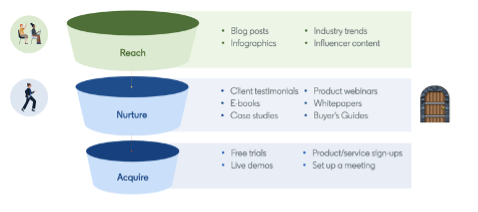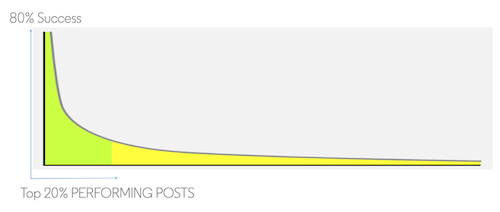3 B2B Content Marketing Strategies to Help Startups Boost Lead Gen on LinkedIn
Content is playing an increasingly important role in the B2B buying cycle. According to Google’s Zero Moment of Truth study, most buyers make it through 90% of their buying journey and consume an average of 10 pieces of content before reaching out to sales.
In addition, LinkedIn research reveals that 92% of B2B buyers start with a general information search, and then head to their networks, specifically their professional networks. Professionals on LinkedIn are intent-driven, meaning they consume content on our platform with purpose; 71% use information on LinkedIn to inform business decisions. This means a strong content marketing strategy is key to lead-gen success here.
With startups’ aggressive growth goals, it’s imperative that their marketing departments align their lead- gen strategies with B2B buying behavior and boost content research and discovery on the sales team. According to DemandWave research, LinkedIn is the No. 1 social platform for B2B lead generation and 80% of B2B leads generated on social come from LinkedIn.
What are the winning content marketing tactics that support startups’ lead-gen strategies? Let’s review the top three B2B content marketing tactics that are helping startups win on LinkedIn.
3 B2B content marketing tactics that drive high-quality and efficient lead gen on LinkedIn
1. Promote balance of content designed to educate and drive action.
Prospects in your ICP fall into two categories – they either need to be educated or are ready to start making purchasing decisions.
Meeting prospects with content in the category that best matches their mindset will result in increased lead conversion rates and efficiencies, and result in more high-quality leads for your sales team.
However, it is incredibly difficult to pinpoint with accuracy and scale what mindset each prospect is in. And prospects are likely to toggle between both categories, especially if you’re dealing with a long sales cycle and larger buying committees.
Startups with successful lead-gen strategies provide an always-on combination of education and action content.
Education content is helpful, non-promotional, and focused on improving knowledge within your startup’s area of expertise. This can include content that addresses your target audience’s goals, needs, challenges or industry trends. Given the audience is seeking to learn, digestible thought leadership is a perfect fit to capture their engagement and generate top of funnel leads. Examples of gated assets that work well for education content include reports, e-books, whitepapers, guides, webinars, and infographics.
Action content is solution-specific, meant to drive next steps toward a buying decision. In this case, your promotional content should illustrate how your product solves a top-of-mind problem and should drive prospects to take further action. Examples of top performing asset types for action content include case studies, testimonials, product sheets, buyer's guides and vendor analysis.
2. Promote case studies featuring new logos.
Case studies are one of the most effective asset types for startups to drive sales-ready leads on LinkedIn.
Startups increase high-quality, efficient lead gen by promoting case studies with new logos for two reasons:
First, case studies solve the lead gen and brand awareness challenge. Due to aggressive growth goals and a laser focus on Return on Ad Spend (ROAS), startups usually prioritize direct lead acquisition over brand awareness when launching new paid strategies. Limited brand awareness, however, can make lead-gen efforts more difficult.
Promoting a gated case study featuring a company with brand recognition is an effective way to simultaneously build awareness, credibility and drive leads. A known logo will catch the attention and interest of your target audience to increase likelihood of lead conversion.
Second, case studies are action content and will accelerate a prospect’s readiness to engage with your sales team. When a prospect downloads a case study, even if they’re still in an educational mindset, learning about your product will move them through the buyer’s journey faster. As such, case study leads often have higher lead-to-sales meeting and opportunity conversion rates.
3. Recycle, repurpose and iterate.
Startups are lean and find ways to do more with less. Content marketing should be no different.
I’ve noticed a trend amongst marketers; many feel pressured to produce more content than is actually necessary. I believe this is because marketers often get sick of their own content well before their audience does.
I’ve found startups with strong lead-gen strategies on LinkedIn repurpose and atomize their top performing content assets. Both derivative content and replaying your greatest content hits work well:
Derivative content can take two forms, either breaking down larger assets to maximize their use or repurposing an asset into a different format.
For example, if a webinar had high registration rates, promote it afterwards as an on-demand evergreen asset. We see higher lead conversion rates with on-demand webinars compared to live webinars because they’re more personalized; prospects can consume the webinar at the most convenient time for them.
If the on-demand webinar is doing well, pull the key takeaways into a whitepaper format. If you produced an e-book that is performing well, break it out into smaller infographics or a guide.
Last, don’t be afraid to repeat your greatest hits by re-publishing your top performing content. If you publish eight pieces of content in a quarter, take the top four performers and re-publish them throughout the year.
You can publish them exactly as they were or if you want to generate more learnings beyond just seasonality you can also tweak certain aspects of the creative. You can try different headlines, different copy, changing the color in the creative, different word choices in the creative.
To get more content marketing insights, subscribe to the LinkedIn Marketing Solutions blog.








